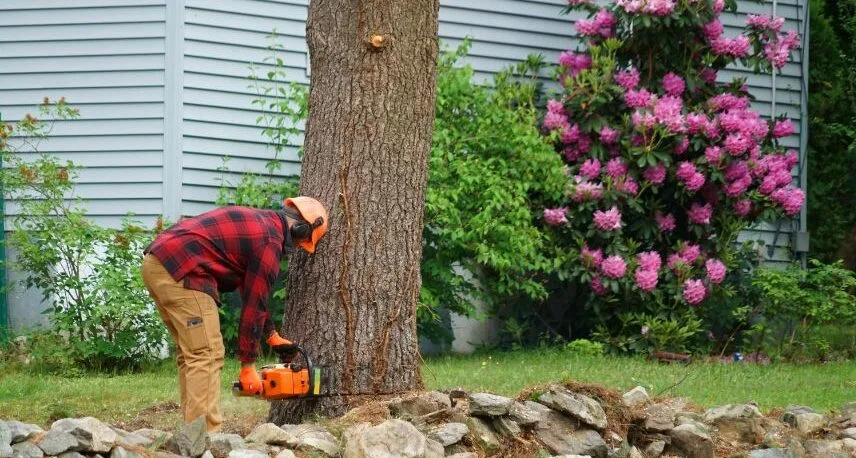Trees play a crucial role in defining the appearance of your landscape. They can transform it into a paradise or make it resemble a graveyard. Focusing solely on bricks and grass while neglecting your trees is a mistake. Regardless of their size or age, trees require consistent care and attention. Employing various tree care techniques ensures they remain healthy and aesthetically pleasing, maintaining the perfect look of your landscape.
Treeservicepeekskillny.com prepared numerous tree maintenance tips that you can implement year-round, even with seasonal changes, to keep your landscape in its prime condition.
PROPER MULCHING
Adding mulch around your trees, when done correctly, offers numerous benefits. It helps retain moisture in the roots, provides insulation from extreme temperatures, suppresses weed growth, prevents soil compaction, and reduces damage from lawnmowers.
3 Steps to Adding Mulch Around Your Tree
1. Clear the Area: Remove any grass within a 3-foot radius for small trees and a 10-foot radius for larger trees.
2. Apply Mulch: Spread wood chips or bark mulch pieces to a depth of 2 to 4 inches within the cleared circle.
3. Avoid the Trunk: Ensure the mulch is kept away from the tree trunk.
WATER REGULARLY
For newly planted trees, a steady stream of water for 30 seconds is sufficient to meet their needs (1) and help establish their roots in the soil. Be sure to cover the soil with wood-chip mulch to retain moisture.
Mature trees, on the other hand, require 10 gallons of water per inch of trunk diameter. For optimal results, use drip irrigation to provide slow and deep watering.
WHEN TO WATER AND HOW MUCH
Dried soil can be just as problematic as soggy soil, so it's essential to maintain a balance. To determine when your trees need water, use a method that accurately shows soil moisture levels.
Insert a garden trowel into the ground to a depth of 2 inches, then move the blade back and forth to create a narrow trench. Touch the soil with your finger; if it feels moist, there's no need to add more water (2). Simply maintain this moisture level.
MANAGE SOIL CONDITIONS
Before planting a tree, it's crucial to select the right soil mix to promote healthy growth. Adding 10-20% compost to the original soil is ideal for a newly planted tree.
Additionally, consider conducting a soil test to determine if fertilization is necessary and to identify the appropriate type of fertilizer for your soil.
FERTILIZE IN THE FALL
As winter approaches, it's essential to prepare your tree's root system for the cold. Applying a specialized fertilizer can help them endure harsh conditions.
Adding phosphorus and potassium to the soil aids in hardening root tissues. Tree care professionals recommend using a slow-release nitrogen (SRN) fertilizer for optimal results in these situations.
TRIM APPROPRIATELY
Trimming diseased and dead branches not only enhances the appearance of your landscape but also promotes the health of your trees. It's best to avoid trimming in the fall, as decay fungi are more prevalent and cuts tend to heal more slowly during this season.
REMOVE INVASIVE PLANTS
Fast-growing invasive plants like Japanese honeysuckle, wisteria, and ivy can trap moisture around the root collar or block sunlight from reaching the leaves.
To remove invasive plants, simply cut the stems near the base. Avoid pulling them from the bark, as this can cause additional damage.
CONTROL PESTS AND DISEASES
Detecting pest invasions or diseases in their early stages can be challenging due to a lack of knowledge. Additionally, homeowners often pay more attention to their flowers than to their trees.
SIGNS OF PESTS OR DISEASE
To effectively treat pests and diseases, monitor your trees for the following signs and take action if you notice:
- Hollowed trunk
- Decaying branches
- Mushrooms near the base
- Slow growth
- Discolored, distorted, or stippled leaves
- White spots or unusual masses on branches
PROTECT AGAINST FREEZES
Young saplings and fruit-bearing trees may need additional protection before the freezing season to ensure they survive the cold.
Cover the trees with a long sheet that reaches the ground to retain some of the soil's warmth, ensuring the cover does not touch the leaves. Once the snow melts, promptly remove the covering from the trees.
Sources:
(1): https://www.arborday.org/trees/tips
(2): https://www.arborday.org/trees/tips
